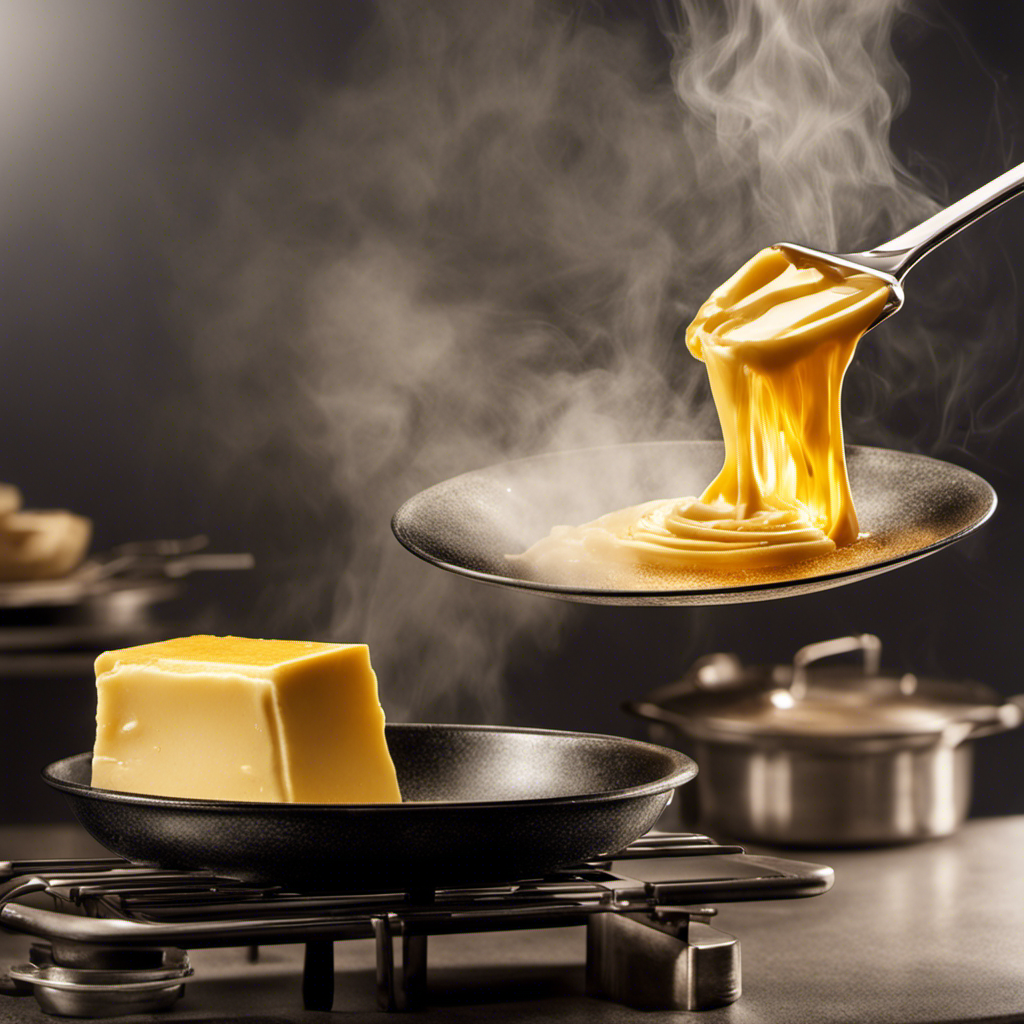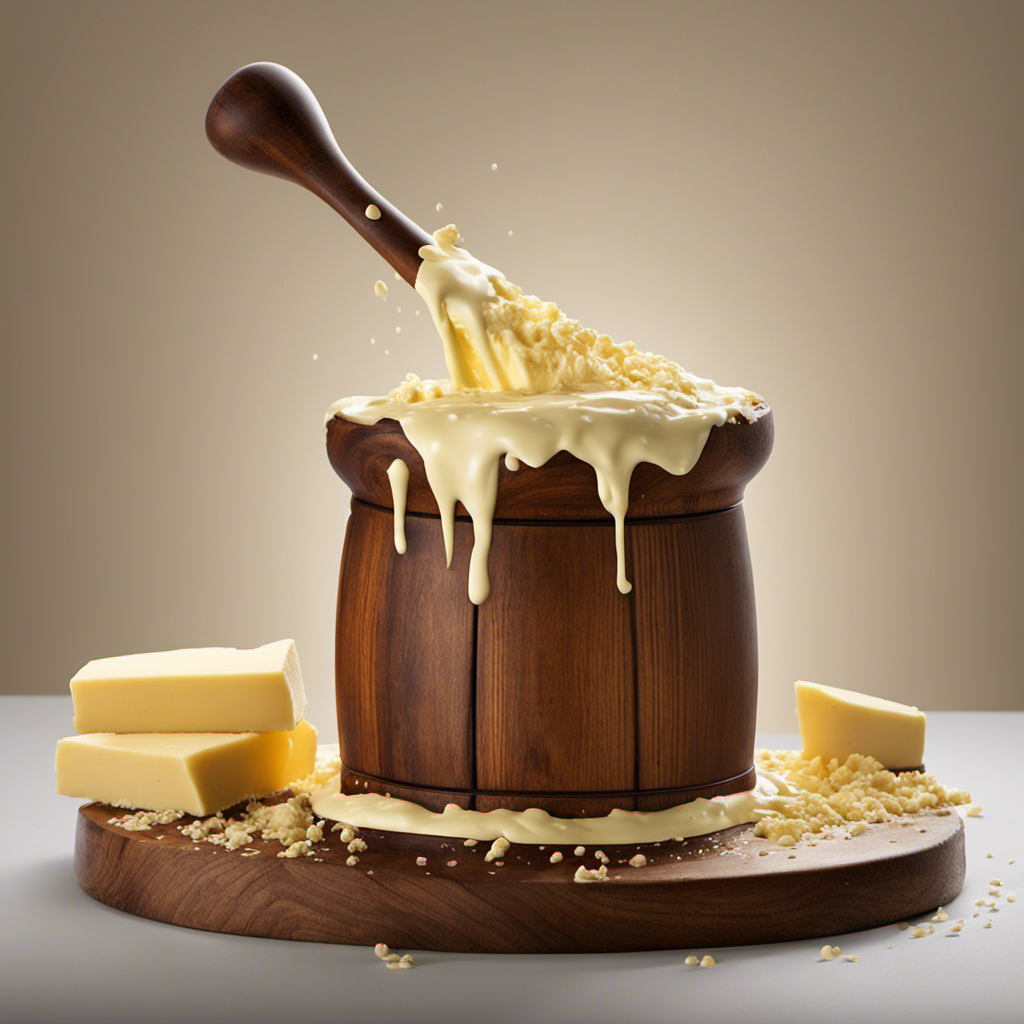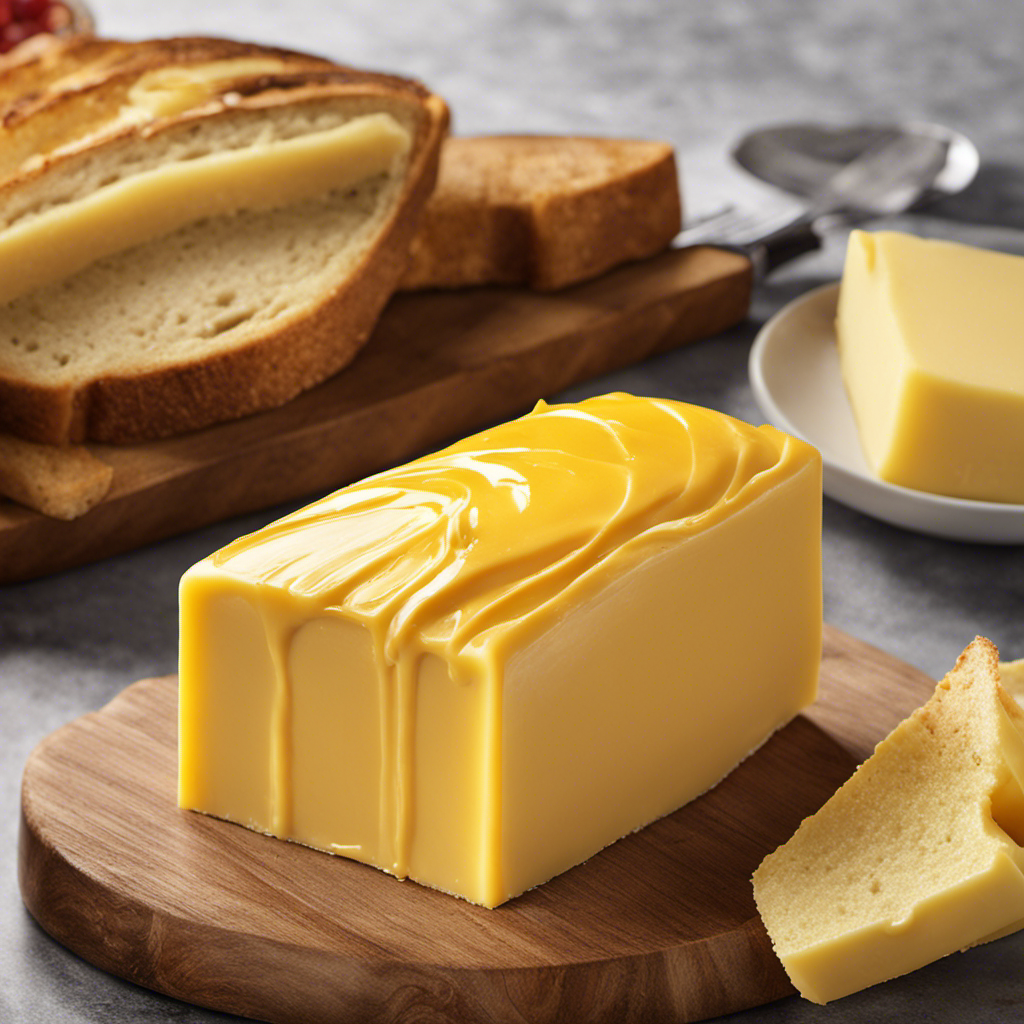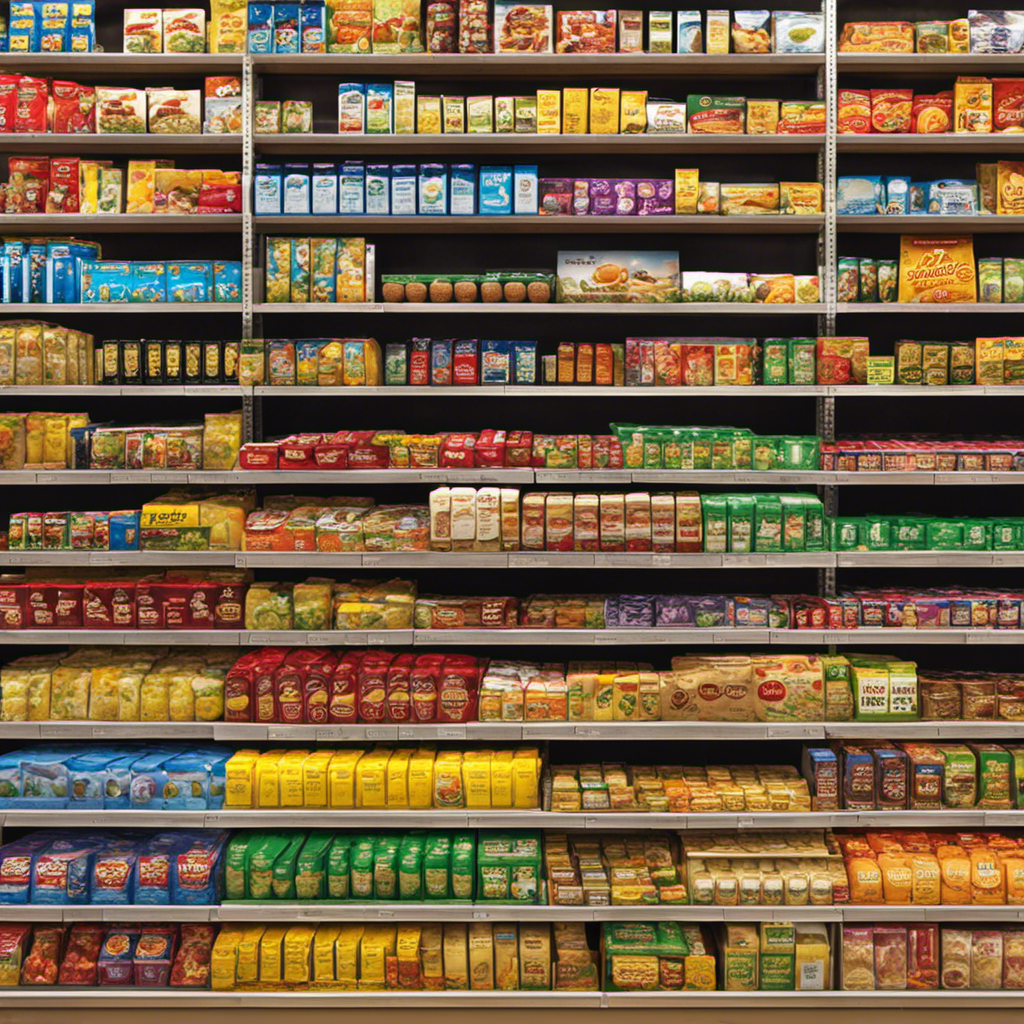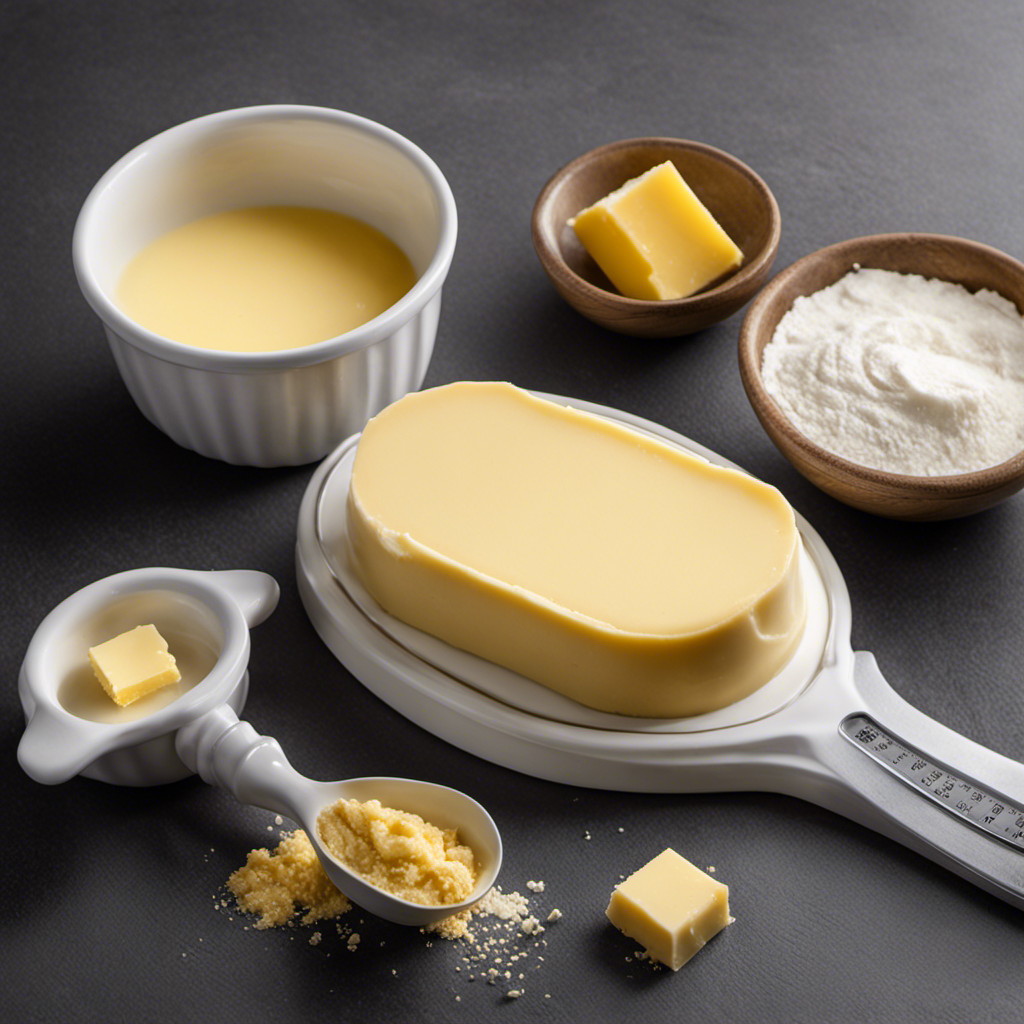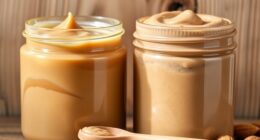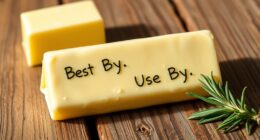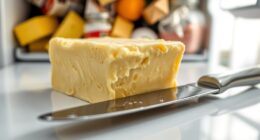I have always been curious about the temperature at which butter begins to burn. Did you know that the smoke point of butter is relatively low compared to other fats commonly used in cooking? In fact, it starts to burn and produce smoke at around 350°F (177°C).
Understanding this crucial information is essential for preventing butter from burning and ruining your dishes. In this article, we will delve into the science behind butter burning, explore factors that affect its burn temperature, and discuss alternative cooking oils with higher burn temperatures.
Let’s dive in and uncover the secrets of butter burn!
Key Takeaways
- Butter undergoes combustion when exposed to high heat.
- The combustion of butter produces a burning smell and smoke.
- Factors affecting butter burn temperature include its lower smoke point compared to other cooking oils, the fat content affecting when it starts to burn, and overheating resulting in a charred and unpleasant taste.
- To prevent butter from burning, start with low heat, use a nonstick pan, clarify butter to increase its smoke point, and consider alternative cooking oils with higher burn temperatures such as avocado or coconut oil.
The Science Behind Butter Burning
The science behind butter burning is fascinating. When butter is exposed to high heat, it undergoes a chemical reaction known as combustion. The key factor in this process is the butter’s melting point, which is around 92 to 97 degrees Fahrenheit (33 to 36 degrees Celsius).
As the temperature rises above the melting point, the fats in the butter start to break down. This breakdown releases volatile compounds, such as water vapor and carbon dioxide, which contribute to the burning smell and smoke. The higher the temperature, the more intense the combustion becomes.
Additionally, butter contains milk solids, which can also contribute to the burning process. Understanding the science behind butter burning allows us to better control cooking temperatures and prevent unwanted burning.
Factors Affecting Butter Burn Temperature
One of the factors that affects when butter starts to burn is its fat content. Butter is primarily composed of fat, which has a lower smoke point compared to other cooking oils. When butter is heated beyond its smoke point, the milk solids and water present in the butter start to burn, resulting in a charred and unpleasant taste.
To prevent butter from burning, it is important to monitor the heat and adjust it accordingly. Using a lower heat setting and adding a bit of oil can help raise the smoke point of butter, preventing it from overheating. Understanding the effects of overheating and taking necessary precautions can ensure that butter is used in a way that enhances flavors without compromising taste.
Transitioning into the subsequent section about how to determine the smoke point of butter, it is important to know the specific temperature at which butter starts to smoke and burn.
How to Determine the Smoke Point of Butter
To determine the smoke point of butter, you can start by heating a small amount in a pan and observing when it begins to emit smoke. This simple testing method allows you to understand how heat affects the butter and at what temperature it reaches its smoke point.
Here are four steps to help you determine the smoke point of butter:
-
Start with a small amount of butter: Use about one tablespoon of butter in a clean pan to ensure accurate results.
-
Heat the butter gradually: Start with low heat and gradually increase the temperature. This allows you to observe the butter’s behavior as it heats up.
-
Observe for smoke: Keep a close eye on the pan as the butter heats. Once you see smoke rising from the butter, note the temperature at which this occurs.
-
Repeat for accuracy: For more precise results, repeat the process multiple times and calculate the average smoke point temperature.
Common Signs of Butter Burning
When it comes to determining if butter is burnt, there are a few key signs to look out for.
Firstly, you may notice a distinct burnt butter smell, which is a clear indicator that the butter has been heated beyond its smoke point.
Additionally, the color of the butter may darken significantly, turning from a pale yellow to a deep brown.
Burnt Butter Smell
The burnt butter smell can be quite strong and unpleasant. It lingers in the kitchen, permeating the air and leaving a distinct odor that is hard to ignore.
Here are a few ways to deal with the smell and remove it from your kitchen:
-
Ventilation: Open windows and turn on fans to circulate the air and help dissipate the smell.
-
Baking soda: Place bowls of baking soda around the kitchen to absorb odors.
-
Vinegar: Mix equal parts of vinegar and water in a spray bottle and use it to clean surfaces and eliminate the smell.
-
Citrus fruits: Cut up lemons or oranges and simmer them in a pot of water on the stove to freshen the air.
Now that we’ve discussed the unpleasant smell of burnt butter, let’s move on to the next section about the darkened color and smoke.
Darkened Color and Smoke
In my previous discussion, I explored the burnt butter smell that occurs when butter is subjected to high temperatures. Building on that, let’s delve into the visual changes that accompany this process. As butter burns, it undergoes a transformation in color, turning a darkened shade. This change occurs due to the Maillard reaction, a chemical process that causes browning. Additionally, the burning of butter releases smoke, which is a visible indication of the degradation of its components. The smoke is primarily composed of volatile compounds that are produced as a result of the breakdown of milk solids and the release of water vapor. These visual cues, the darkened color and the accompanying smoke, are valuable indicators of the butter’s state and can help us determine when it has reached its burning point.
| Darkened Color | Smoke |
|---|---|
| Result of Maillard reaction | Indication of degradation |
| Caused by high temperatures | Composed of volatile compounds |
| Visible indicator of butter burning | Produced from breakdown of milk solids |
Preventing Butter From Burning in Cooking
To prevent butter from burning while cooking, it’s important to adjust the heat accordingly. Here are some techniques I use to prevent butter scorching:
-
Start with low heat: When melting butter, begin with low heat to avoid overheating and burning. This allows the butter to melt slowly and evenly.
-
Use a nonstick pan: Nonstick pans help prevent butter from sticking and burning. They also require less heat, reducing the risk of scorching.
-
Clarify the butter: Clarified butter has a higher smoke point, making it less likely to burn. To clarify butter, melt it slowly and skim off the milk solids that rise to the top.
-
Monitor the heat: Keep a close eye on the heat while cooking with butter. Adjust the temperature as needed to maintain a gentle heat and prevent scorching.
Alternative Cooking Oils With Higher Burn Temperatures
When it comes to cooking at high temperatures, it’s important to consider safer options that won’t easily burn or produce harmful smoke.
Fortunately, there are alternative cooking oils available that have higher burn temperatures, making them suitable for high-heat cooking methods like frying and searing.
Not only do these oils offer safer cooking options, but they also come with additional health benefits compared to traditional options like butter or vegetable oil.
Safer High-Heat Options
For safer high-heat options, you can use oils like avocado or coconut. These oils have higher smoke points compared to butter, making them suitable for cooking at higher temperatures without burning.
Here are four reasons why these oils are great butter substitutes when it comes to safer cooking methods:
-
Avocado oil: With a smoke point of around 520°F, avocado oil can withstand high temperatures without breaking down or producing harmful compounds.
-
Coconut oil: This versatile oil has a smoke point of about 350°F, making it suitable for most cooking methods, including baking and frying.
-
Neutral flavor: Unlike butter, avocado and coconut oils have a mild, neutral flavor that won’t overpower the taste of your dishes.
-
Health benefits: Both avocado and coconut oils are rich in healthy fats and have been associated with various health benefits, such as improving heart health and aiding in weight loss.
Health Benefits of Alternatives?
Using avocado or coconut oil as butter substitutes offers you the opportunity to experience the health benefits associated with these oils.
When it comes to cooking, coconut oil is an excellent choice. It has a high smoke point of around 350°F, making it suitable for high-heat cooking methods like frying and sautéing. Coconut oil is rich in medium-chain triglycerides (MCTs), which are easily metabolized by the body for quick energy. These MCTs have been shown to support weight loss, improve brain function, and boost immune health.
Another popular alternative to butter is ghee, a form of clarified butter. Ghee is rich in fat-soluble vitamins like A, D, E, and K. It also contains conjugated linoleic acid (CLA), a fatty acid that has been linked to numerous health benefits, including reduced inflammation and improved heart health.
Frequently Asked Questions
Can Butter Burn at Room Temperature?
Yes, butter can burn at room temperature if it is exposed to high heat for a prolonged period. When butter overheats, the milk solids in it start to brown and release a burnt smell.
What Is the Difference Between the Smoke Point and Burn Temperature of Butter?
The difference between the smoke point and burn temperature of butter is crucial. The type of butter affects its burn temperature. As the saying goes, "knowledge is power" when it comes to understanding butter’s behavior at high temperatures.
Can the Type of Butter Affect Its Burn Temperature?
The quality of butter can affect its burn temperature. Factors such as the type of butter (salted vs. unsalted) and its composition can impact the burn temperature.
Are There Any Specific Cooking Techniques That Can Help Prevent Butter From Burning?
Are there any specific cooking techniques that can help prevent butter from burning? Here are some tips for adjusting cooking temperature when using butter and how to use butter in high heat cooking without burning.
What Are Some Alternative Cooking Oils With Higher Burn Temperatures Than Butter?
There are alternative cooking oils with higher burn temperatures than butter. Using oils with higher burn temperatures can prevent burning and provide better results in high temperature cooking.
Conclusion
In conclusion, understanding the temperature at which butter burns is crucial for achieving culinary perfection.
By delving into the science behind butter burning and considering the various factors that affect its burn temperature, we can prevent culinary disasters and create delectable dishes.
Remember, just like life, cooking is a delicate balance. With knowledge and precision, we can avoid the bitter taste of burnt butter and savor the sweet success of a perfectly cooked meal.
So, let’s embrace the heat and elevate our cooking skills to new heights!
